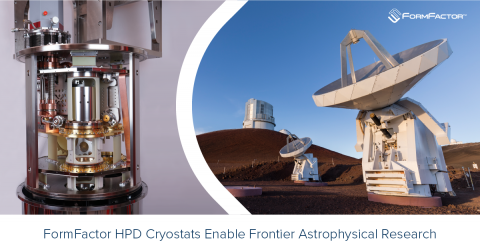FormFactor engineers recently had the thrill of designing and building two prototype HPD cryostats for the Submillimeter Array on Maunakea in Hawaii. The SMA is a collaborative project between the Smithsonian Astrophysical Observatory (SAO, a member of the Center for Astrophysics | Harvard & Smithsonian) and the Academia Sinica Institute of Astronomy and Astrophysics.
The SMA consists of eight radio telescopes operating from 190 to 410 GHz (1.6 to 0.7 mm wavelength), that work together as an interferometer to function as a single, high-resolution telescope. It excels at studies of cold gas and dust in the nearby universe, and red-shifted radiation from the cosmic past. The SMA is also a key element of the Event Horizon Telescope, a collection of radio observatories across the world that work together as a single Earth-sized telescope (think of the SMA array but the size of the earth’s diameter) to image black holes and their violent surroundings.
The new cryostats that SAO and our engineers co-designed and integrated each house two new cryogenic millimeter-wave receivers at 4K that operate near the quantum limit of sensitivity. The receiver modules are housed in removable cartridges so that they can be easily exchanged by scientists in the field on Maunakea. This enables efficient maintenance of these sensitive components, and facilitates upgrades as new or improved designs are developed. The cartridge modules use kinematic mounting and automatic thermal links to allow the cartridge modules to be easily changed out while retaining precise and repeatable positioning and alignment of the receiver and its associated feed optics. This is crucial for maintaining consistent pointing of the SMA’s eight radio dishes.
The cryostat also houses a FormFactor-designed cryogenic filter wheel at 50-60K to switch different cooled millimeter wave optical elements into the observation beam path. The filter wheel is positioned between the two receiver cartridge modules to enable flexible selection of single- and dual-receiver operation, polarization modes, and calibration.
SAO has plans for additional cryostats that will serve as critical infrastructure to carry the SMA into its next generation of astrophysical discovery.
